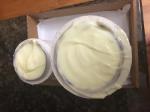Ripply lumps on top of the soap
I've been making soap for about a year and a half now, When I make it I am doing 3 or 4 batches at a time that are 3, 6, or 9 lbs. each.
I have a new problem that has never occurred in any other batch. I notice that within a few hours of pouring that it has these lumpy ripples all over the top. I read on one of your other Q & A's that this is from over heating. I didn't do anything different so I am not sure what happened.
Could you give me any more information about this. I have looked at a bazillion trouble shooting tables and cannot find anything about it. Is this symptomatic of overheating at a specific point in the process?
The last two times that I have made soap it has happened to 1 of the batches. Both times I was using formulas that I have used many times with great success.
The first time it got weird was with a recipe using olive oil, palm, and coconut. However, it was the first time I had ever infused the olive oil with anything, and I did so with rubbed sage. I used sage and juniper berry essential oils. It was also a first time to use sage essential oil. It was a 3 lb. batch.
The second time was lavender essential oil in a batch with oatmeal. It was a 9 lb. batch.
Answer:
Any change, no matter how small it seems, can affect how the soap reacts and developes.
Believe it or not, when I was first starting to make soap, I discovered that if I placed my soap to insulate in one particular spot in my soap room, the soap would get hard crumbly edges. Turns out that spot had a draft that disrupted the insulation temperature.
Changing batch size, using some essential oils and herb infusions can definitely change how hot the soap gets.
Larger soap batches get hotter than smaller batches do. Some essential oils and herbal infusions will heat up soap more than others.
Other things that can affect the process are using different molds, household temperatures, humidity and different insulating materials to name just a few.
Always keep an eye on your soap after you pour. I like to feel the soap mold every couple of hours after pouring to see if the mold is getting hot. If it is, I check to see if the soap has fully gelled or not and unwrap the mold if it has.
Also be sure to take detailed notes of each batch...especially those that have issues. This may help you to discover if there are any similarities between the batches that might be causing the problems.
Cathy

